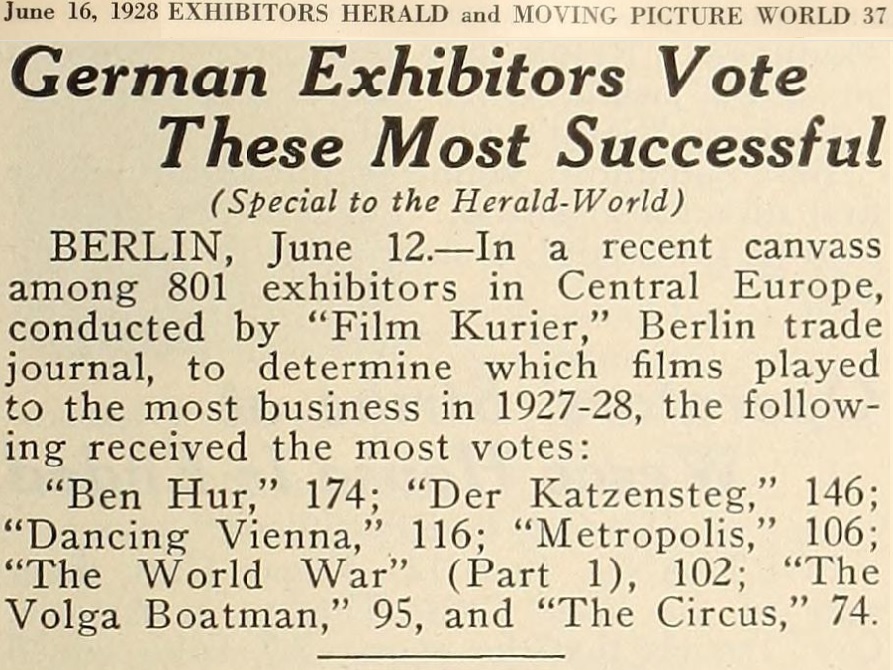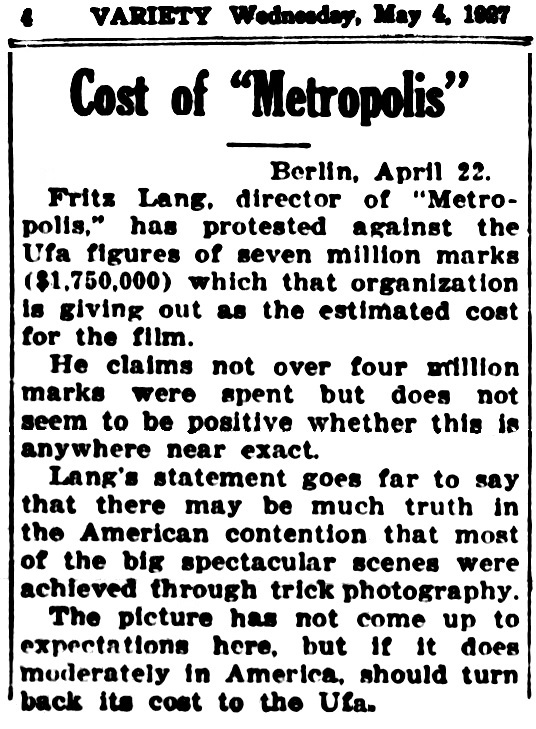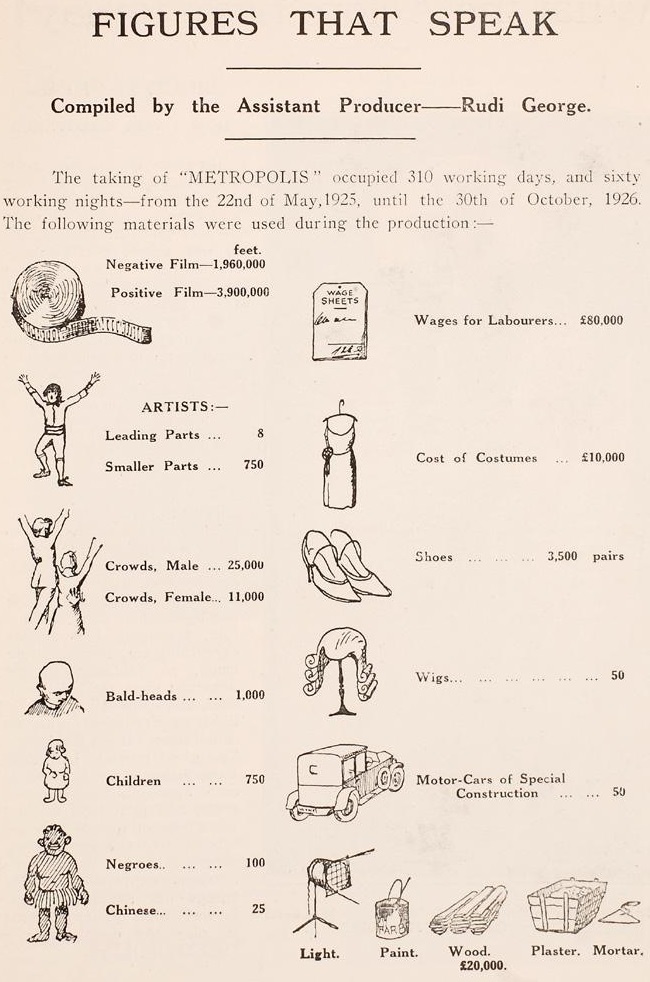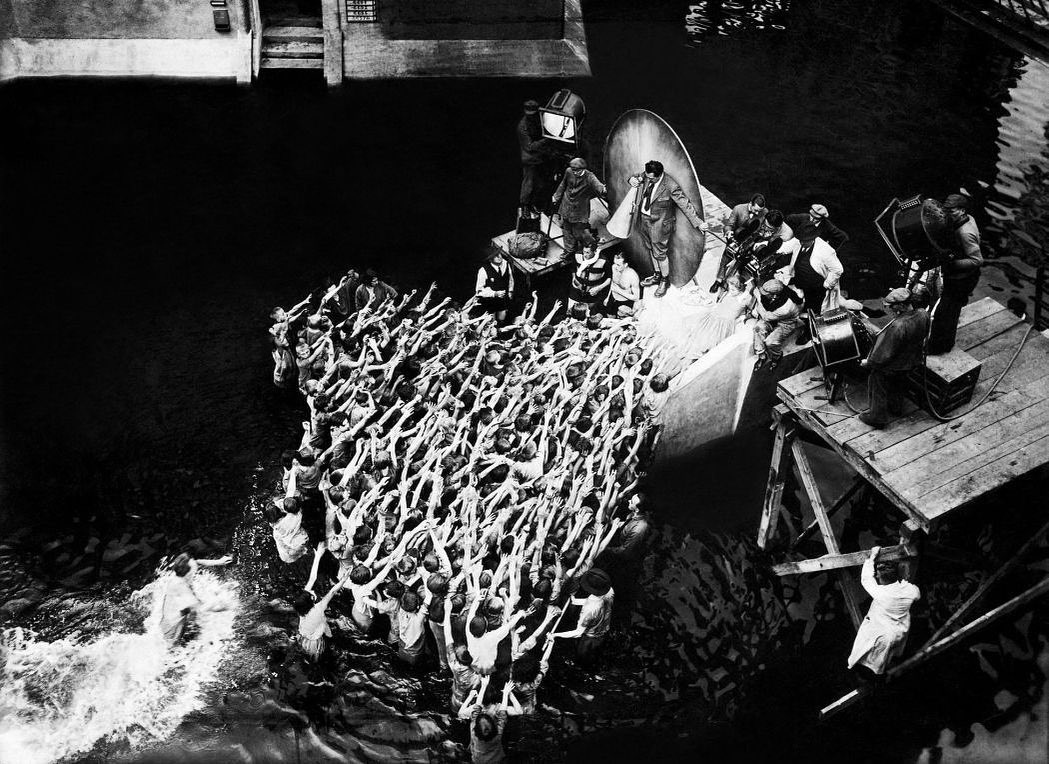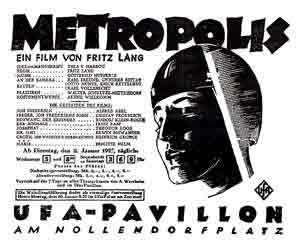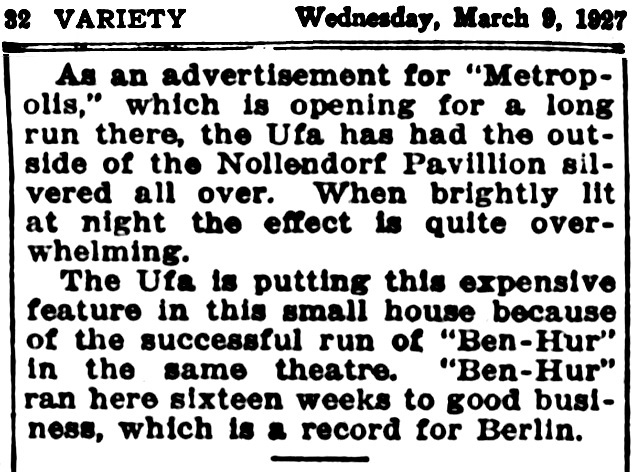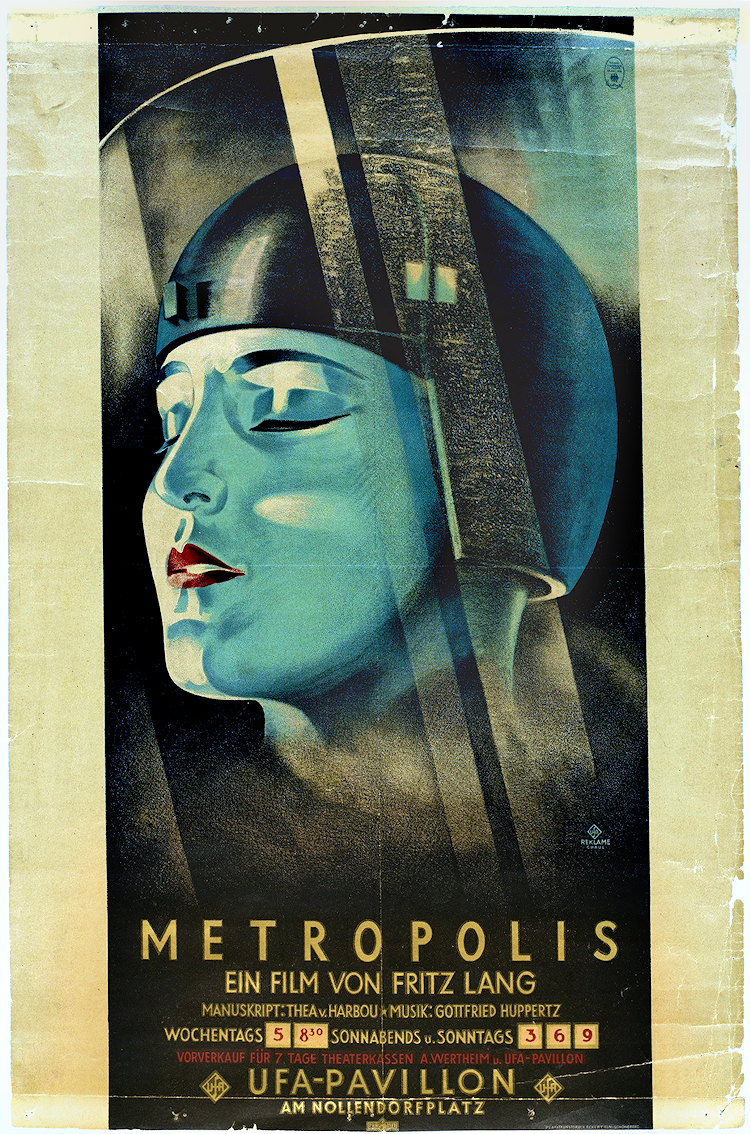| Return home |  |
Return to previous page |
August 1927: Ufa Copycats Paramount
Let’s move back in time a year or so.
Here’s a typical summary, from “Trivia / Metropolis,”
tv tropes:
|
This movie cost 5.1 million Reichsmarks and made just 75,000 Reichsmarks at the box office;
in modern terms this is the equivalent of a $293 million movie earning back $10 million.
|
From what I can gather, this is Commonly Accepted Knowledge.
Say that out loud, slowly and confidently: Commonly Accepted Knowledge.
This is the Commonly Accepted Knowledge with which scholars all agree.
Now I shall demonstrate why I am not, never have been, never shall be, and never can be a scholar:
The German market for German movies was kneecapped,
but we see here that the Central European market for at least some German films was still quite strong.
For the curious:
Ben-Hur, US, MGM, 1925
Der Katzensteg, German, National Film, 1927
Dancing Vienna (Das tanzende Wien), German, Deutsche Fox, 1927
The World War (Part 1) (Der Weltkrieg, 1. Teil - Des Volkes Heldengang), Germany, Ufa, 1927
The Volga Boatman, US, PDC, 1926
The Circus, US, United Artists, 1928
Der Katzensteg, German, National Film, 1927
Dancing Vienna (Das tanzende Wien), German, Deutsche Fox, 1927
The World War (Part 1) (Der Weltkrieg, 1. Teil - Des Volkes Heldengang), Germany, Ufa, 1927
The Volga Boatman, US, PDC, 1926
The Circus, US, United Artists, 1928
Previously, US cinemas could book German movies for cheap.
So, from 1921 through about 1925, German productions performed splendidly at the US box office.
The cost to Hollywood distributors and to cinemas was negligible, and the returns were rather good.
That was essentially free money.
To phrase it a different way: German movies were successfully competing with Hollywood movies.
At first, that was okay.
But then the reichsmark began to stabilize and the German economy began to recover, and so the rental prices went up.
That made German movies less attractive to US distributors and US cinemas.
Now, to earn a profit in the US, the German films would need to be more aggressively promoted,
and thus put into competition with Hollywood product.
The Hollywood bosses did not look kindly upon that prospect.
Even so, the quality of German films was so fine that the German studios
were actively, vocally, openly attempting to supplant Hollywood as the world’s movie capital.
The Hollywood bosses didn’t like such talk.
Capitalists abhor competition.
If a German star proved popular with Americans,
Hollywood lured that star away with a much larger salary.
That wasn’t enough, though.
The Hollywood studios decided to fix the problem by purchasing shares of German studios to gain controlling interest.
Their investments served to regulate the German productions.
Then there was something called ambition.
Thomas J. Saunders,
Hollywood in Berlin: American Cinema and Weimar Germany (Berkeley, Los Ángeles, London: University of California Press, 1994):
|
More than any other producer, UFA staked its reputation, and ultimately its existence, on gaining entry to the American market.
In the first half of the decade it embarked on a bold program to challenge Hollywood.
Although its own production output was a fraction of that of the largest American companies,
it distributed a disproportionate share of German motion pictures.
In 1924 it opened a branch office in New York to supervise distribution rights in America
and launched an impressive drive to expand its theater holdings in Germany.[48]
Furthermore, under Erich Pommer it produced a number of art and/or big budget spectacles —
Die Nibelungen, Der letzte Mann, Tartüff, Faust and Metropolis —
which were intended as Germany’s answer to Hollywood.
When these pictures failed to justify the expense with substantial American earnings,
UFA encountered severe financial difficulties.
Already at the beginning of 1925 it borrowed fifteen million marks to remain solvent.
At the end of the year the Deutsche Bank, the principal investor in the company,
recalled its loan and UFA accepted slightly more than this sum again from Paramount and Metro-Goldwyn.[49]
48. See BA-UFA R109I/510, indexed as UFA Films Inc. N.Y., with the letter from von Stauss to F. W. Jones in New York (1 August 1924)
outlining the aims of the new company.
UFA simultaneously sought to raise its American profile through personal diplomacy in Hollywood.
See “Empfang in Los Angeles,” Lichtbildbühne, 15 November 1924, p. 17.
49. See BA-UFA R109I/1046, Geschäftsbericht 1924–1925,
in which expenditures in all branches of the firm were portrayed as excessive given the general economic situation,
but absolutely necessary in the face of American inroads.
Cf.
|
Think whatever you like, but I call that stupidity that lent itself to a setup.
There was no way on earth that foreign films could any longer compete with Hollywood films in the US.
The Hollywood studios had a lock on what was shown at cinemas,
and why should the Hollywood studios allow rivals to outperform?
It would never happen, and it could never have happened.
Let us look at the titles mentioned in the quote above.
Die Nibelungen was not shown in its entirety.
Only the first part, “Siegfried,” was shown, and to get it shown in the United States,
Ufa had to rent the cinemas itself:
The Century and then the Rialto in Manhattan,
the Capitol in San Francisco, and
Philharmonic Auditorium (aka Clune’s) in Los Ángeles.
The Hollywood distributors decided against placing a bid, and so Ufa shipped the film straight back to Germany.
Der letzte Mann was retitled The Last Laugh and was not given wide distribution.
Tartüff was released in the US after a two-year delay, and again got almost no exposure.
Metropolis was chopped to ribbons and released as a minor attraction.
When you play a game against the guy who makes the rules, you’ll lose.
Why the Ufa executives failed to understand that is beyond me.
Hollywood began funding German productions,
and that was a gift horse that the Germans foolishly accepted without first looking in its mouth.
The report is that Metropolis
“was made with American money,”
and the implication is that it was made only with American money.
The Hollywood studios then made backdoor deals that, in exchange for US distribution,
German cinemas would book Hollywood flicks rather than homegrown product.
Hollywood productions now dominated the German market.
To make the deal sweeter — for German cinemas, not for German studios —
Hollywood then shipped over movies that had already amortized
and rented them at cut-rate prices, far below the rental costs of German films,
thus undercutting even the domestic market for German studios.
The Hollywood studios were putting the German studios into a vise and turning the handle mercilessly.
German films were only barely shown in the US,
and the Hollywood studios made deals with the German cinemas
that guaranteed that German films would only be barely shown in Germany.
That ended the competition.
Hollywood made a killing.
German studios suffered.
So typical.
Hollywood studios made the Mafia look like bumbling amateurs by comparison.
(Hollywood studios were also infiltrated by the Mafia — and other crime groups, too, I’m sure.)
The US and US corporations have never learned the art of wielding soft power.
They know only brute force and extortion.
That leads to deep anger and resentment,
which offer the perfect breeding ground for totally insane politicians to take over.
Now, to be fair, Erich Pommer did return to Ufa
(see Patrick McGilligan, Fritz Lang: The Nature of the Beast, London: Faber & Faber, 1997, p. 168),
and he served as producer on Fritz/Thea’s next project, Spies, a marvelously entertaining movie.
For its minor US release, MGM chopped Spies to confetti, utterly ruining it,
and thus guaranteed that it would not compete against Hollywood product.
I’m not an expert here, but I’m not an idiot either.
Just by looking at some basics easily findable on the Internet and in a few fairly common books, I can see in rough outline what happened.
In those days, the exchange rate was about 4.2RM to US$1.
The average programmer cost about 175,000RM, or about US$41,700.
Metropolis was budgeted at 800,000RM, or about US$190,500 (Elsaesser, BFI Guide, p. 21).
That, I suppose, is probably about what it actually cost.
According to Elsaesser, Ufa claimed that the final cost was 4,200,000RM (about US$1,000,000).
Press releases, which should never be believed, boasted that the original budget was nearly double the reality, 1,500,000 Reichsmarks,
and that it then exploded to 5,300,000 Reichsmarks.
According to the Variety article above, Ufa claimed that the final cost was 7,000,000RM.
Fritz Lang cited the exaggerated cost as a grievance in his lawsuit against Ufa.
Fritz did not know what the film cost, but he knew for certain that the total was not even close to Ufa’s varying claims.
Press releases, which should never be believed, claimed that Metropolis employed
“758 actors, 36,000 extras, 1,100 bald men, 750 children, 100 blacks, twenty-five Chinese,”
and required “1,600,000RM for salaries, 200,000RM for costumes,
as well as more costs for 3,500 pairs of shoes, seventy-five wigs, fifty specially designed cars....”
Yeah right.

Behold the one hundred blacks and the twenty-five Chinese.
I am willing to wager that these three people were in the nightclubs when Fritz and his casting director approached them about being photographed for the upcoming movie.
Well, maybe I’m wrong.
There are seven slaves supporting the powder-puff container.
They are not evenly spaced, and so we can see five of them.
They do not move.
They do not breathe.
They do not have pulses.
They are body casts.
When bodies are cast, though, they are cast from bodies.

We saw this above. We can study it a little more now.
Now we learn the identity of one of those bodies.
Courtesy of Janine Wass,
“The Island of the Lost,”
scifist 2.0 : A Sci-Fi Movie History in Reviews (7 May 2022),
we see a photo of one of those bodies visiting the set:

The shirtless guy is Louis Brody, and he seems to be the one who posed for the slave downstage center.
So, okay, I give in.
Seven black men loaned their bodies for casts to be used as props in the film.
That gets us a little closer to the claim of 100.
Not much closer, but a little closer.
If you are curious, we can adjust for inflation,
though there are multitudes of problems when doing so, especially since inflation calculators do not take sufficient account of housing costs.
US$1 in 1927 was supposedly about US$17.06 in 2023 money.
Shall we?
| RM | US$ | In 2023 $ | |
| Average programmer | 175,000RM | US$41,700 | US$711,402 |
| Original Metropolis budget | 800,000RM | US$190,500 | US$3,249,930 |
| Ufa’s claimed total Metropolis cost | 4,200,000RM | US$1,000,000 | US$17,060,000 |
| Original Metropolis budget according to press release | 1,500,000RM | US$357,150 | US$6,092,979 |
| Total Metropolis cost according to press release | 5,300,000RM | US$1,262,000 | US$21,529,720 |
Let’s put this into perspective.
The highest claim is proffered by press releases, which should never be believed,
which insisted the total cost was 5,300,000RM, or about US$1,262,000.
That was about the cost of a Douglas Fairbanks movie.
When we plug that into the inflation adjuster, that supposedly becomes US$21,582,095 in today’s money.
So, the officials were saying that the equivalent of a single Douglas Fairbanks movie bankrupted Germany’s biggest studio?
Remember also that nobody on this film was earning a Fairbanks salary.
After all, the two leads were unknowns!
That in itself saved a boatload of money.
Now the exaggerations have been further exaggerated.
The latest claim I know of is that the film cost 5,000,000RM which,
adjusted for inflation, would be
US$200,000,000
in today’s money.
People just love to overstate everything, don’t they?
Just look at the screen.
Use your eyes.
Use your noggin.
There ain’t nuthin’ that expensive on camera.
How can people be so gullible?
How do such preposterous stories find their way into print in respected publications?
Why does nobody call out this idiocy, this patent absurdity?
The movie cost a little over $190,000, which is a little over $3,000,000 in modern money.
Paramount footed most or probably all of the bill, and so the movie did not bankrupt Ufa.
Please don’t exaggerate. Please.
It would be interesting to draw out a table of German movie productions throughout the 1920’s,
with columns for title, release date, alleged original budget, alleged final cost, verified original budget (if known), and verified final cost (if known).
I have no clue how to pursue such a project.
If you want to pitch in and do it yourselves, you have my blessings!
Please forward your results to me. Thanks!
Wednesday, 22 February 2023: I just received Thomas Elsaesser’s
BFI guide to Metropolis,
which reveals (pp. 40, 102fn48) that studio overhead was debited against Metropolis,
as were costs from another production, Faust.
Please take a look at Ann J. Drummond’s July 1987 thesis,
Metropolis: An Historical and Political Analysis, p. 28:
“...one critic has claimed that it was no secret in the film trade at the
time that expenses incurred by other productions such as Murnau’s
were simply shifted onto Metropolis’ account.(42)”
When we scroll down to page 272 to see note 42, we find:
“See reviews in Der Kinematograph and Lichtbild-Bühne.”
So what else is new?
So typical. So, so, so, so, so typical.
Most of that claimed 4,200,000RM cost of Metropolis was actually spent elsewhere, not on this film.
Such an old trick, a trick that was commonly used at least into the 1980’s and is probably still being used nowadays.
Here’s something else that’s curious.
If I were to learn German and dig into the files so that I could write a book about Metropolis,
the finances and financial subterfuges would be my focus.
I would examine why the Ufa executives unanimously settled upon a policy of giving Fritz the silent treatment at best
and of treating him rudely when meetings were unavoidable.
Was Fritz partly at fault for this breakdown in relations?
Probably.
Many people have a dark side.
Some people have pretty much only a dark side.
Fritz’s dark side was darker than dark; it was a
downright black hole.
(Nonetheless,
I have zero reason to believe that he was married more than once or that he killed anybody.
His alleged victim, Lisa Rosenthal, seems never to have existed.
It was a story, a whispering campaign, a whispering campaign that, oddly, Fritz once participated in, himself!
Rumors are rumors. Don’t believe rumors.)
It is hardly surprising that his employers grew fed up with him.
I would also examine Fritz’s lawsuit against Ufa.
I would examine the exhibits produced in court that proved other studio expenses were debited against Metropolis.
I would examine the pressure exerted by Paramount and other Hollywood studios
to knock German films out of the running and replace them with cheap Hollywood product,
a policy that brought German movie production to its knees.
Fritz seems to have been blacklisted not long after Metropolis,
and that is why he set up his own production company to negotiate with Ufa,
and that is why he soon accepted two jobs from a poverty-row studio to make
M
and The Testament of Dr. Mabuse.
You see, that’s the interesting part of the story.
Not meanings and messages and opinions.
That’s boring.
Shenanigans with money, now that’s what’s interesting.
Why do most books make no mention of this?
The few that do note of any of this relegate their remarks to a passing mention or to a single footnote.
Mostly they just toe the party line that the Metropolis cost overruns bankrupted Ufa,
a patently false story that is utter nonsense.
The frequent claim that Metropolis was “the most elaborate and expensive film made in Germany to that date” is laughable
(Gunning, The Films of Fritz Lang, 2000, p. 53).
It was expensive, quite obviously, but not outrageously so.
Every cost-saving device was employed, and the trickery is more than evident.
Ancilla Jerez Metz, “Vintage's world: Everything is about vintage”,
Quora:
“Fritz Lang’s ‘Metropolis’ (1927) miniature movie set, as seen in the German Cinema Museum (Deutsche Kinemathek) in Berlin.”
This is not the original, of course. This is a reconstruction, almost certainly created especially for the museum.
In the original, the New Tower of Babel in the background was a drawing, not a miniature.
You can surely spot other differences as well.
The corresponding image from the film is below:
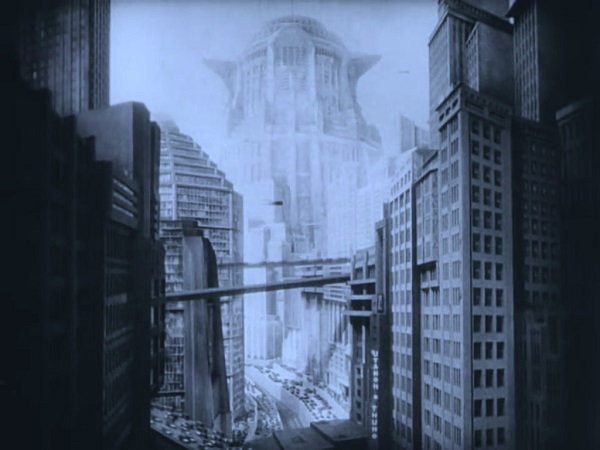
When you watch the movie, please test your powers of perception:
Where are the 36,000 extras?
Try to spot them.
Are they hiding behind the sofa?
Maybe they’re all in the bathroom?
I know! I know! They’re crouching underneath the bench at the bus stop!
That’s it! That’s where they are! They’re hoping that Der Schmale won’t notice them.
The sole shot that seems to contain a thousand or so extras is actually a visual trick performed with mirrors and multiple exposure (see below).
My best guess is that the total number of extras was in the hundreds, probably less than 500 grownups and less than 200 little kids.
So typical.
Here’s the recipe:
Appear behind a lectern or in front of a TV camera.
That makes you an “authority,” especially if you claim to have written a book of some sort.
Show a photograph of a few hundred people, thunder forth that it is an image of 36,000 people, and everybody will believe you.
Your claim will be repeated in endless newspaper articles and on social-media posts.
Scholarly books will cite your claim as confirmed
and renowned encyclopedias will repeat your claim and before you know it, it’s
Commonly Accepted Knowledge.
Works every time.
The one person out of every half million who says “That’s not what I see” is derided
as a delusional paranoid conspiracy theorist.

Above is one of the two shots I cannot completely figure out.
The few men up front are photographed through a transparent spot in a mirror.
There was only one queue of men in the background, each row seven across (of course it would be seven, of course),
but that single queue was multiplied to five with an arrangement of mirrors.
(If you’ve ever lived in Buffalo, you can call those five fingers, left to right,
Genesee, Sycamore, Broadway, William, Clinton.)
Those five queues, though, are not synchronized.
So, this was a multiple exposure, with a single queue photographed in a mirror five times over,
each time with a second mirror aimed differently.
That queue looks really long, doesn’t it?
Blurry though it is, I count about 35 rows stretching back to the gate in the distance.
It looks like more than a hundred rows, but when I enlarge the image and count heads,
it’s only about 35 rows deep.
Multiply: 35 × 7 = 245.
Now, the queue is moving, and so there were plenty more than 35 rows, maybe half as many again.
I just purchased Gunning’s book on The Films of Fritz Lang,
and on page 58 he mentions:
“This is probably the shot that cameraman Karl Freund described as a multiple re-printing
of a shot of a thousand men to make them look like six thousand — a trick necessary, he claimed, because
Ufa could not find enough extras willing to shave their heads.”
Elsaesser’s BFI Guide tells us a little more on page 102, footnote 58:
“The extras playing Egyptian [sic] slaves
were taken from the Berlin dole queue not because actors were not prepared
to shave their heads (one can see on stills that some of the slaves are not shaven),
but because Ufa could claim back from their wages a tax discount....”
Indeed, further back we see hair, but it’s so blurry and indistinct that nobody in the audience would pay any attention.
If you have more details about how this was done, please let me know. Thanks!
There were only a few large sets, built inside large studio stages, and the backgrounds were miniatures and paintings.
So don’t believe the claims about the ballooned budget.
That was just publicity hype.
The film did, though, take a long time to produce, not the usual two or three months, but
almost a year and a half, 22 May 1925 through 30 October 1926.
Or so the story goes.
Why do I have my doubts?
Cinema scholars assume that was 17 months of filming.
Impossible.
For the sake of argument, let us say it truly was 17 months of production.
Let’s see what 17 months really meant.
First of all, such a lengthy production schedule was typical for Ufa productions of the time.
It would be helpful to get a detailed daily production log, the shooting records, the camera reports, the continuity notes, the call sheets.
I don’t suppose any of that survives.
What else can we do?
Well, can we learn something from readily available sources?
Yes, we can!
We can learn a lot.
According to IMDb, Alfred Abel appeared in one other film in 1925 and four others in 1926.
Gustav Fröhlich appeared in three other films in 1925.
Rudolf Klein-Rogge appeared in one other film in 1925 and four others in 1926.
Fritz Rasp was in five other films in 1925 and five others in 1926.
All right. But they were actors who did not appear in every scene.
They could have been working on several films at once, spending different days on different productions.
Fine.
What crew members would have been on set every day of principal photography?
The camera crew!
Cinematographer Karl Freund was on two other 1925 movies and one other 1926 movie.
Günther Rittau was cinematographer on two other 1925 movies.
Another cinematographer, Walter Ruttmann, directed another feature in 1925 and directed two shorts in that year as well as two shorts in 1926.
The camera crew, remember, would have been needed not right from the first,
but certainly in the latter part of the 15 months of set construction and effects design.
They had plenty of other days during those two years to take other jobs.
Actual filming could not possibly have taken all that long.
I bet that principal photography was only about two months, or three at the very most, not more.
It was the effects crew who had only a single credit in those two years.
So, obviously, about 15 of those 17 months were devoted
to building sets and miniatures and painted backgrounds
and to creating special effects, physical effects, and optical effects,
and I further surmise that the work was done with a very small crew.
In Hollywood, a crew of hundreds would have hammered all that together in a few weeks.
Berlin did not have the same luxury, apparently.
So, there you go.
That was the reason for the extended schedule.
Little of those 17 months was devoted to actual filming with the actors.
Almost all of those 17 months was devoted to a small crew working on set construction and miniatures and backgrounds and effects.
A better guess, pending the discovery of further documentation, is that Eugen Schüfftan and his crew
negotiated to spend most of 1925 tinkering with mirrors and models, and the studio agreed not to interrupt their work.
This was not specifically for Metropolis, but just to develop an effects process for use in whatever might need it.
Other than that, 1925 was probably just calendaring and bureaucratic paperwork and working out costs and needed labor,
and, of course, scripting.
Production probably did not begin until about May 1926,
and principal photography would not have commenced prior to August 1926.
This leads to another fascinating revelation from conductor
Frank Strobel, who documented that
Gottfried Huppertz
was engaged in composing his score throughout the 17 months or whatever it was.
He began composing to the script, and, when it came to Fritz’s films, that was possible, since
Fritz did not improvise.
He followed his scripts scrupulously.
_-_sheet_music_2Y2nqMoZHOE.jpg)
Click to play
METROPOLIS | Suite from the Movie Score (Huppertz op. 29, 1926) - sheet music
Ascended from Silence, https://youtu.be/2Y2nqMoZHOE, posted on 31 October 2020
When YouTube disappears this, download it.
Press releases, which should never be believed, marveled at the shooting schedule of 310 days and 60 nights,
for which 620,000m (376 hr 41 min) of negative was consumed,
and 1,300,000m (789 hr 50 min) of positive printed.
If scholars can believe that, it is hardly surprising that nonscholars fall for psychics and astrologers and demagogues.
My heavens!
The figures are preposterous, and anybody who even momentarily entertains the idea that they might be accurate
should check himself in to the nearest mental ward.
There could not possibly have been much more than about 100 hours of negative consumed.
NG takes were not printed.
Construction and planning occupied about 15 months with a crew of probably 30 or fewer,
and these 15 months also included a number of effects shots,
some of them with extras pulled from the dole queue.
Principal photography was about two months, maybe three.
The assistant editors put together preliminary assemblies throughout the shooting,
and once shooting was completed, the editing proper was just over one month.
As Fritz okayed the growing German edit, the assistants cut the US and export editions to match.
There were not many more than about 500 grownup extras, probably less, and probably less than 200 little kids.
It was not “the most elaborate and expensive film made in Germany to that date,”
it did not go overbudget, and it did not bankrupt the studio.
That reminds me:
For whatever it’s worth, Ufa is an acronym for Universum Film-Aktien Gesellschaft.
There is no question but that the executives who invented that acronym were perfectly familiar with the Italian exclamation “uffa!”
Pattern. Pattern. Pattern.
I begin to detect a pattern.
Whenever you hear a story about how a film went drastically overbudget, be careful.
Chances are that someone is playing a trick on you.
When the bosses say that a film went overbudget, that is usually because those bosses are swindling somebody,
and by pointing to a supposedly out-of-control production, they are providing a distraction as cover.
Once in a blue moon, yes, a movie really does go overbudget (for instance 2001: A Space Odyssey),
but usually such stories are just stories.
Don’t be fooled.
The movie business is totally crooked, totally corrupt, built on lies, rotten to the core.
Don’t believe the tall tales.
And don’t believe
anything Fritz Lang ever said, either.
All right, this is just barely beginning to come into focus.
Fritz, though talented and a true artist, and though he could be really nice when he needed to be,
was utterly toxic and tended to alienate pretty much everybody.
His producer-buddy , Erich Pommer, who initiated Metropolis,
warned his fellow executives at Ufa that they were about to commit financial suicide by aligning with Paramount and MGM.
The fellow executives then blamed Erich for all their problems and squeezed him out.
The Ufa executives discovered that Erich was right all along, as they lost every pfennig,
and so they charged standard operating costs as well as the production of Faust
and other films, too, against Metropolis,
and blamed Fritz for their bankruptcy.
Fritz was blackballed.
A fascist oligarch took over Ufa and decided to make massive changes.
One change would be to break the Hollywood alliances.
Another change would be to turn Metropolis into a standard programmer rather than a deluxe specialty item
and be done with it once and for all.
If I may be permitted to add a little bit of context, well, I shall add a little bit of context.
Prior to television, films were shown once.
A movie came to your town to play for maybe a week, maybe half a week, maybe two days, maybe only one day,
and if you missed it, you missed it.
It would never return.
If you lived in a bigger city, the movie would play maybe a week downtown,
and then over the next few months it would pop up at the discount neighborhood houses a couple of times,
and then it was gone forever.
There were rare exceptions — exceedingly rare exceptions.
(The Birth of a Nation and Tillie’s Punctured Romance were periodically revived in new editions,
and there may have been two or three other features that were brought back a few years after the initial run.
Some shorts by Arbuckle, Chaplin, and Hart were put back on the market,
sometimes in new editions under new names to trick audiences into thinking they were paying for something new,
but those were the rare exceptions.)
Movies were shipped from one town to the next over the course of two or sometimes three years,
and when they reached the end of the line, they were junked, as they had completed earning their money and were considered utterly valueless.
Negatives were junked, as there was no prospect of the films being reprinted or reissued.
The full edition of Metropolis had its première roadshow engagement at TWO cinemas in Berlin.
Everybody knows that it premièred at the 2,165-seat Ufa-Palast am Zoo
on 10 January 1927, with Gottfried Huppertz conducting his own score.
I do not know how long it played there.
I keep running across a reference that it played a few weeks, whatever that means.
The booking at the Ufa-Palast am Zoo came to an end, obviously, due to a prior contract to show another film.
Aitam Bar-Sagi has brought forth sufficient evidence that Metropolis had a double première that same night,
for it also opened at the
640-seat
Ufa-Pavillon am Nollendorfplatz, with Richard Etlinger conducting Huppertz’s score
(I would guess an arrangement for a smaller orchestra).
It ran through 10 May 1927 or possibly through 13 May 1927, a
four-month engagement, which was phenomenal.
|
Did you think it was odd to move the film out of the
|
The film seems also to have had extended runs in Austria, Hungary, the Netherlands, Estonia, Czechoslovakia, Argentina,
and probably in other countries as well.
Based on that information alone,
I would hazard a guess that the film was not a box-office failure at all, but rather the opposite.
See the Exhibitors Herald clipping above.
Oh, I can hear it now; I can hear the objections,
“But it was the original that flopped; once it was shortened it was a success!”
No. That doesn’t happen. Ever.
Let us invent a hypothetical dialogue.
WIFE: I really want to see Metropolis, but I refuse to go because it’s not bowdlerized.
HUSBAND: Well, dear, I just read in the foreign trade press that an abridgment is in the works.
WIFE: Oh goody goody! Then we’ll both go see it after it’s truncated.
Why did the film not quickly spread to other deluxe première cinemas in major German cities?
My guess, the only guess I can come up with, is that someone didn’t want it to,
because someone had other ideas about how Germans should be spending their entertainment reichsmarks.
That leaves the question about why Ufa decided to copycat Paramount and slash away at the German edition of the movie,
especially since the German edition had done so spectacularly well.
Puzzling.
I do not know the answer, but I can think of a couple of possibilities.
Ufa had committed financial suicide by aligning with Paramount and MGM,
and all its blood was sucked away.
That is why the company suffered a hostile takeover in March 1927, while Metropolis was still being roadshowed.
Who was the new owner?
A German oligarch by the name of Alfred Hugenberg, that’s who.
Perhaps Alfred Hugenberg’s most notable achievement was helping a certain Adolf Hitler become Chancellor.
Anyway, Hugenberg was a new broom.
Hugenberg was vehemently anti-labor and he opposed Ufa board member Paul Silverberg’s
idea that Industry should hold its hand out to labour.
He rejected any peaceful social partnership with labor.
Chances that Hugenberg bothered to watch Metropolis are probably nil,
but his underlings surely viewed the film and reported back that it would not meet his approval.
That was almost certainly the principal reason why Metropolis was massacred.
The Berlin edition of the movie was 4,189m, which is 13,743', and it was run at a hair above 26fps (about 98'/min.),
and so it ran about 2:20 plus an intermission.
We can see from
the blurry Nollendorfplatz advertisement above that the curtain times
on weekdays (Wochentags) were 5:00 and 8:30, and on weekends (Sonnabends u. Sonntags) they were 3:00, 6:00, and 9:00.
Perhaps, PERHAPS, other cinemas did not want a 2:20 movie but rather something significantly shorter, to allow four shows per day.
Maybe?
Cinemas seemed to prefer one-hour or hour-and-a-half features.
Ufa chopped the movie to 3,241m, which is 10,633', which would run about 1:49 at 26fps.
Interestingly (if that’s the word), when this abridgment was shipped out to cinemas,
it supposedly came with instructions to be run at 28fps (105'/min.), which got the running time down to 1:41.
That was 39 minutes shorter than the original Berlin edition, and that would easily allow an extra show each day,
I would guess something like 2:00, 4:00, 6:00, 8:00.
Could that be the reason? Maybe.
Gottfried Huppertz rearranged his 2:20 orchestral score for a 1:41 piano performance,
and if you have a piano in your living room,
you can have some fun.
We also need to keep in mind that Hollywood was undercutting German prices,
and the nabes preferred cheap Hollywood product, which was more popular anyway.
If they absolutely had to book a German pic, it had better be a quickie.
A more mundane possibility, I would guess, maybe,
is that Ufa, like Paramount and Wardour and other distributors, was being paid to do something,
and, to justify their salaries, they did something,
but the only something that was available to do required blades and scrapers together with a mixture of
collodion, acetic ether, alcohol, amyl acetate, ether, and acetone.
Remember also: An orchestra costs a lot more money than a piano player.
There is the possibility that German cinemas did not want to shell out the big bucks to put on a German movie
and pay for an orchestra to rehearse and accompany
when they could get a dumb Hollywood movie for dirt cheap and have a piano player improvise to it.
The dumb Hollywood movie for dirt cheap would be far more profitable.
Anyway, we need to think of this a different way.
Première roadshow screenings were long,
but the editions dumped onto the nabes were much shorter.
That was a longtime pattern,
and that pattern held true for Metropolis.
That was surely not the original plan for Metropolis, but it became a fallback position.
Impressed by Channing Pollock’s ideas,
the (new?) Ufa executives made a business decision to recut the German negative
more or less along the same lines.
The result was 35 minutes shorter than the original, and Ufa destroyed the negatives of those 35 minutes of deletions.
After all, the roadshow engagements were finished and the executives were certain that the full film would never need to play again.
Why keep it? It had served its purpose, it expired, and now it was waste of valuable storage space.
Pretty much all copies in distribution anywhere in the world were thenceforward more or less conformed to Pollock’s revision.
Nobody, absolutely nobody, could have anticipated that anyone in the future would have the least interest in viewing the full film after its initial playdates.
It was over. It was done. It was old. Nobody wanted to see anything that was old.
Actually, I’m rather surprised that even the short edition was kept on file at the studio.
You know what’s super-stupid about Channing Pollock’s abridgment?
Think. Think. Think again. No. Nope nope nope nope nope. Not that. That’s not what I’m talking about.
Come on. Try again. Put on your thinking caps!
Yeah yeah yeah, abridging contrary to the author’s wishes is almost always a stupid thing to do, but that’s not what I’m getting at here.
Yeah yeah yeah, cutting out vital plot elements is stupid, but that’s not what I’m getting at here.
This is what’s super-stupid :
The length of the film could have been reduced by 30 minutes or more without sacrificing a single shot,
without reducing a single character,
without sacrificing a single plot element,
without ruining the pacing, without diluting the comical elements,
without hurting the feel, without hurting the flow, without compromising the drama or the suspense,
and it could have been done under Fritz Lang’s supervision.
As Giorgio Moroder proved in 1984 (see below), with a few seconds trimmed off the beginnings and endings of shots,
and occasionally with a few seconds gently trimmed out of the middles of shots,
and with a little more intercutting, the story could have maintained its integrity even when reduced by 30 minutes or so.
If the bosses really needed to reduce the running time, that would have been the proper way to do it,
and everybody, even Fritz, would have been happy.
Well, Gottfried Huppertz and his copyist and his orchestra would have been irritated, but they could have adapted.
Personally, I would have preferred that the film had never been trimmed,
but if it had to be trimmed, it should have been trimmed intelligently, not with a butcher’s knife.
The journalist selectively quoted.
We know what brought on Fritz’s tirade.
He was in a rage because it was Hollywood that had mutilated his film.
Hollywood had declared war against Germany.
Now Fritz was declaring war against Hollywood.
The unnamed journalist omitted Fritz’s grievance,
because he knew who was buttering his bread.
By omitting the core of the story,
the journalist made Fritz sound like a babbling maniac.
Of course, Fritz was a maniac, but not a babbling one.
What he said to the journalist was quite justified.
I keep running across a quote, but I can nowhere find the source of that quote, and so the quote may be apocryphal.
A.J. Goldmann,
“‘Metropolis’ Now,” The Wall Street Journal,19 February 2010:
|
Late in life, the director is reported to have answered a question about Metropolis
from the author Robert Bloch by asking, “Why are you so interested in a picture that no longer exists?”
|
Now, take a look at
“TRP plays silent film classic, Metropolis (1922),” The Reese Project Silent Film Series, 21 November 2008.
See also Lynn René Bayley, “Fritz Lang’s ‘Metropolis’: Film as Art,” The Art Music Lounge, 5 May 2020.
Did you scream?
JAPAN
I put this here only because I don’t know where else to put it.
Apparently Metropolis was released in Japan.
IMDb puts the release date as 3 April 1929,
but that does little to explain the poster below, which specifies
“SUNDAY MARCH 4th! The wait is over!”
March 4th fell on a Sunday in 1928, not 1929.

Gods and Foolish Grandeur
The title at the top, written in some ultramod type that my phone doesn’t recognize,
is most likely メトロポリス, but I won’t swear to it.
I pointed my phone at the above and received the following message:
|
め始を座竹松都五日三月四々愈
!切封斷縱本日舘設常表代大八國全 The first day of the festival will be on March 4th. The following is a list of the most important things that we can do to help you. This course is designed to represent the entirety of the Eight Kingdoms.
METROPOLIS 園公草淺市京東 ・ 堀頓道區南市阪大 Enkongkusa Asaichi Kyoto (Garden grass shallow city Jingdong) • Horitomo, Minami-shi, Osaka 供提部入輸座竹松 Provide the bamboo pine | |
|
ルビ橋本日區橋本日市京東 Ruby Hashimoto Hi Dist. Bridge Today City Gyeongdong 店理代給配東關、會商橋高 Shopkeeper for Dongguan and Kaisho Kashiwa Takashi |
三四町西市戶神 Sanshicho Nishi Ichidogami 店理代總給配國全 Store Manager for Countrywide |
|
社ムル#フータス 含商橋高 ShaMul#Futus Shohyo Bridge High School | |
Methinks something got lost in the machine translation.
